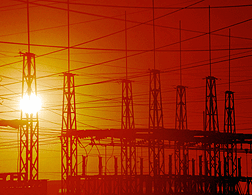FOR IMMEDIATE RELEASE
December 10, 2001
Two new methodologies can help owners improve security of nation’s dams and power systems
|

The Risk Assessment Methodology for Dams (RAM-D) provides a formal, scientific process for evaluating and improving the security of the nation’s 75,000 dams.
|
ALBUQUERQUE, N.M. — Operators of U.S. dams, hydroelectric facilities, and power transmission systems can make their sites less attractive targets to terrorists using new step-by-step security assessment processes developed by the Interagency Forum on Infrastructure Protection (IFIP), a team of government dam owners, transmission system operators, and anti-terrorism experts.
The IFIP includes representatives of the FBI, U.S. Army Corps of Engineers, Bonneville Power Administration, U.S. Bureau of Reclamation, Sandia National Laboratories, Lawrence Livermore National Laboratory, Southwestern Power Administration, Western Area Power Administration, and others.
The two new processes, called RAM-DSM for “Risk Assessment Methodology for Dams” and RAM-TSM for “Risk Assessment Methodology for Transmission,” takes owners, operators, and security managers of dams and transmission systems through a magnifying-glass examination of each facility’s unique situation — its potential adversaries, vulnerabilities, consequences of attack, and existing security measures — then provides cost-benefit analyses of possible security upgrades.
The methodologies are based on many of the formal risk-assessment tools and techniques used by Sandia to protect U.S. nuclear weapons facilities. Sandia is a Department of Energy (DOE) research and development lab with expertise in the physical security of national facilities and infrastructures.
“This is much more than a checklist,” says Rudy Matalucci, Sandia RAM-D and RAM-T project leader. “It begins with the events you don’t want to happen, identifies who might want to do it and what their resources are, and quantifies how much risk reduction you get with each given upgrade. It is a way to help facility owners make decisions about how to balance the need for security with other considerations.”

The Risk Assessment Metholody for Transmission (RAM-T) provides a formal process for evaluating and improving the security of power transmission systems.
Download 300dpi JPEG image, ‘grid2.jpg’, 232K (Media are welcome to download/publish this image with related news stories.)
|
|
In simplest terms, RAM-D and RAM-T include characterization of a facility; evaluation of the consequences if the facility is attacked; definition of potential adversaries and their motives and resources; quantification of risk; detailed analysis of a facility’s vulnerabilities; and cost-benefit analysis of possible upgrades.
Dam operators might use RAM-D, for instance, to determine where to place sensors, cameras, or lights, or whether to invest in walls, barriers, higher fences, better doors, extra training, or improved policies.
The methodology includes worksheets for evaluating existing security features, equations for calculating risk, and a proprietary fault-tree analysis tool for identifying vulnerabilities.
Each methodology is contained on a compact disk and in two inch-thick manuals.
To develop RAM-D and RAM-T, IFIP conducted trial assessments on four actual dams and a major regional transmission system.
It is the first scientifically verified security assessment process for key elements of U.S. water and power supply infrastructures.
IFIP’s work was inspired by two Presidential Decision Directives issued in May 1998 encouraging federal agencies to find new ways to deter and prevent terrorist attacks on US information systems, facilities, and infrastructures.
For information about acquiring the RAM-D Field Manual and Training Guide, contact Sandia at 505-844-2311. RAM-T is currently being finalized and is expected to be ready for release by January 2002.
Sandia is a multiprogram laboratory operated by Sandia Corporation, a Lockheed Martin Company, for the United States Department of Energy under contract DE-AC04-94AL85000. With main facilities in Albuquerque, N.M., and Livermore, Calif., Sandia has major research and development responsibilities in national security, energy and environmental technologies, and economic competitiveness.
Media contact:
John German, jdgerma@sandia.gov, (505) 844-5199
|
